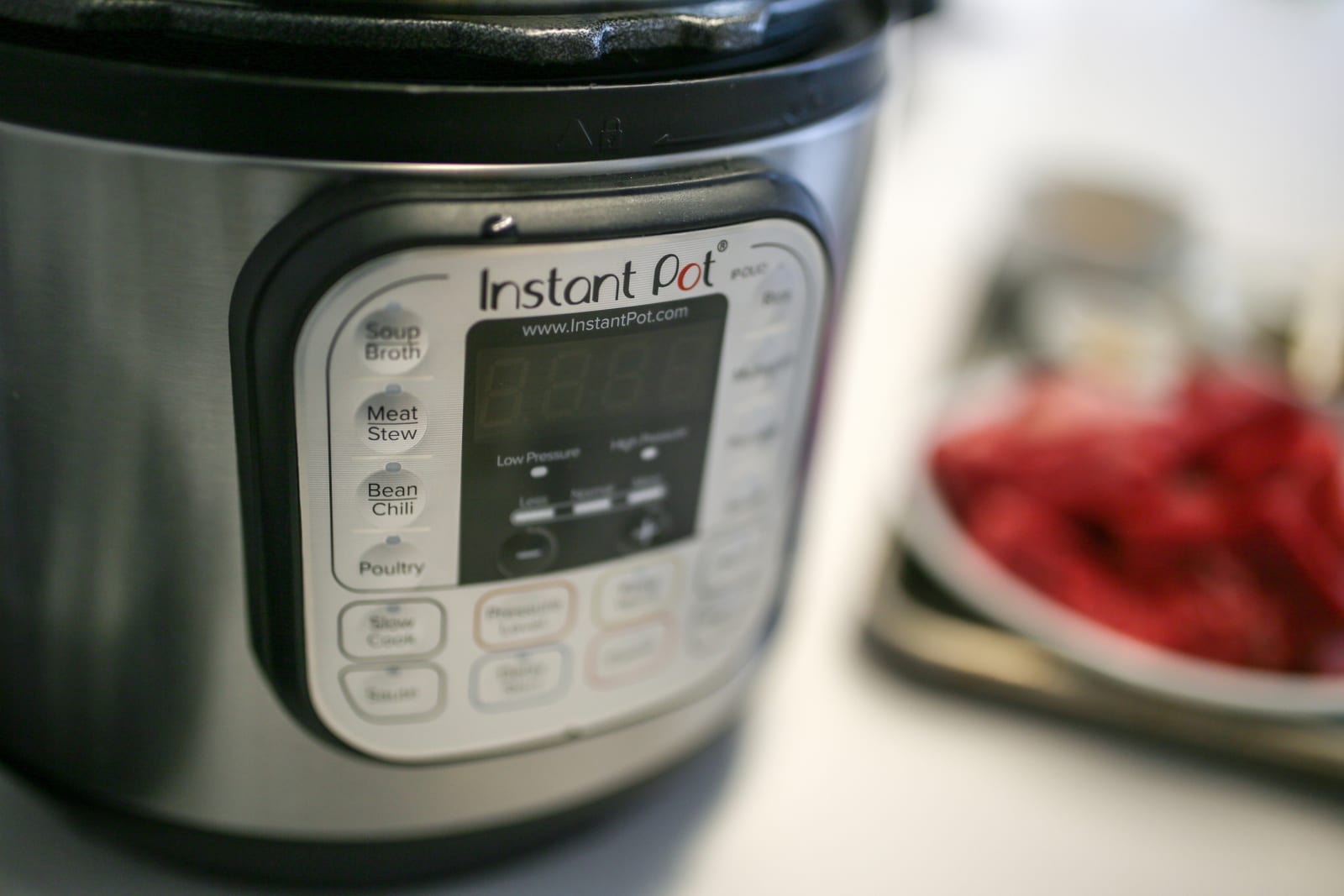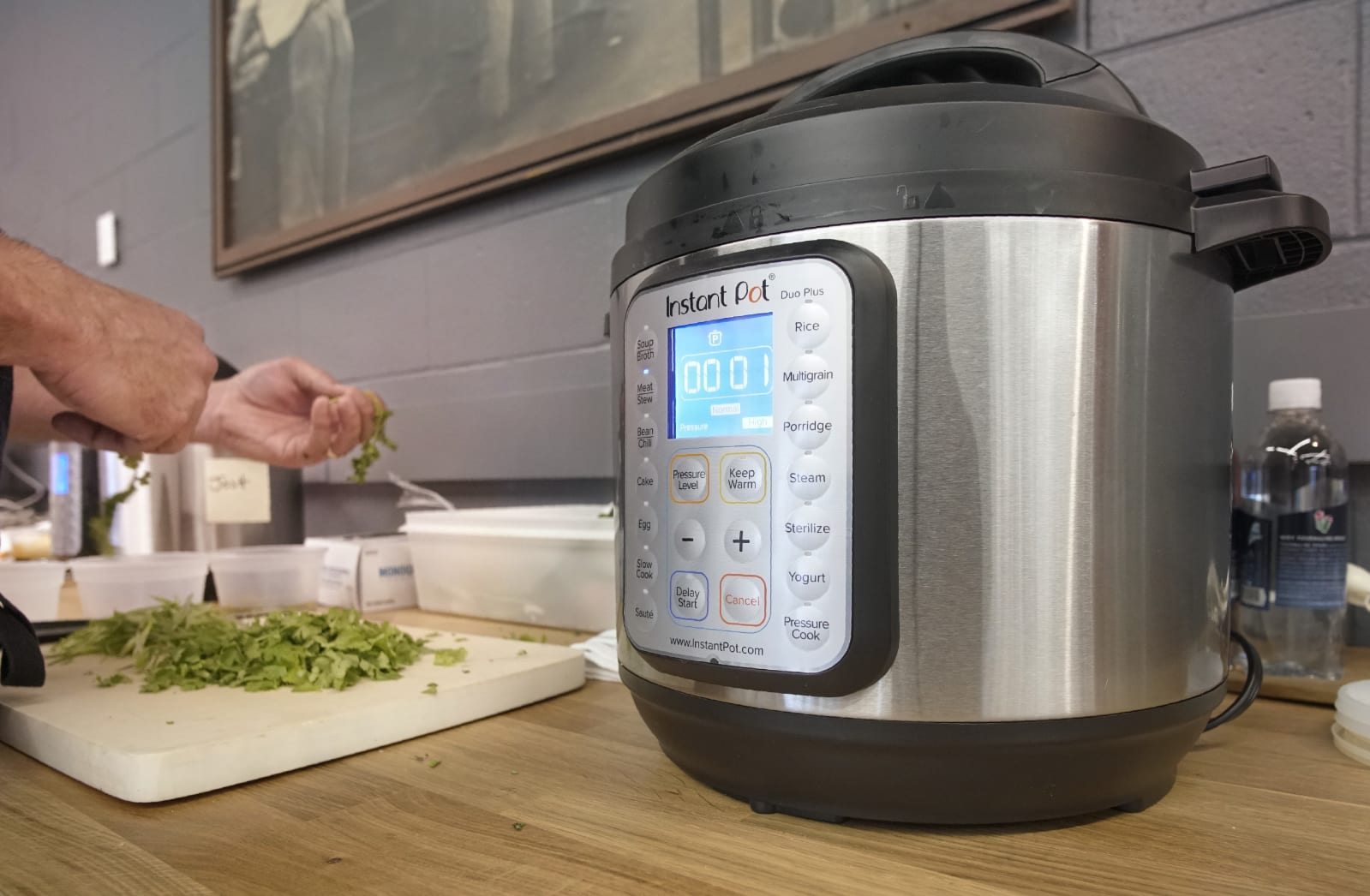How to make the most of that Instant Pot you just bought
The Instant Pot is one of those rare kitchen appliances to reach not just cult status, but broad mainstream appeal. An “all-in-one” multicooker that promises to replace a rice cooker, a yogurt maker, a slow cooker and more, the Instant Pot has risen to fame in part thanks to its versatility and also the fact that it’s a good electric pressure cooker. This lets you cook food at an accelerated rate — think pulled pork in an hour, or chicken curry done in 10 minutes. And because it’s electric, you just press a few buttons and walk away without having to keep an eye on it.
It’s no wonder why the Instant Pot has become a favorite among home cooks, even those of us on the Engadget staff. Not only have a few of us bought it for ourselves, we've recommended it in past gift guides. Sure, it's not a gadget in the traditional sense (although there is a WiFi-connected version with an app), but it does have a lot of crossover appeal thanks to its promise of all-in-one efficiency.
But what do you do when you get one? With so many recipes on the internet and so many different things you can do with it, where do you even start? In this guide, I'll attempt to give you a primer on the first steps you should take when you get one, some tips and tricks on how to use it and a few favorite recipes and source links. A lot of this comes from personal experience; I've been an Instant Pot owner for a few years. I'll also note that the listed recipes reflect my own taste, but hopefully this guide will provide a good start for your own culinary adventures.
How Instant Pots work

For the uninitiated, the Instant Pot is an "all-in-one" kitchen gadget that promises to replace a rice cooker, a yogurt maker,a slow cooker and more. But the real reason the Instant Pot has risen to fame is that it's also a very good electric pressure cooker. This lets you cook food at an accelerated rate; imagine pulled pork in an hour instead of five or a chicken curry done in 10 minutes. And because it's electric, you just press a few buttons and walk away. Unlike a stovetop pressure cooker, there's no need to keep a constant eye on it.
There are several Instant Pot models to choose from. Some of the lower-end ones lack the yogurt mode, and a couple of the higher-end models have extra features like sous-vide cooking and canning, but all of them have the pressure cooker function, and indeed, much of this guide focuses on that.
Which Instant Pot model is right for you?
Best for most: Instant Pot Duo (6-quart)
There are several Instant Pot models to choose from. Some of the lower-end ones lack the yogurt mode, and a couple of the higher-end models have extra features like sous-vide cooking and canning, but all of them have the pressure cooker function.
The Instant Pot Duo strikes the right balance of features, size and power for most people. It has pretty much every function you’d want, including modes for sauté, slow cooking, yogurt making and of course pressure cooking. We find that the six quart model is perfect for a couple who likes to meal-prep or have leftovers, or for a family of four.
Best for single users: Instant Pot Duo (3-quart)
Living by yourself? Then you might want to scale down to the three quart model, which has most of the same features as the six-quart model, except in a smaller footprint.
Upgrade pick: Instant Pot Pro
The Instant Pot Pro is designed for enthusiasts, offering an assortment of upgrades over other Instant Pots. The inner bowl has an extra thick bottom that can go on the stove, plus it has handles so it’s easier to lift. It comes with 28 customizable programs for different foods, and there are five favorites buttons that you can assign to frequently used settings. The steam release switch has also been upgraded to reduce noise and splatter, and there are even steam release reminder alerts with 5- and 10-minute pre-sets. The Pro is also one of a few Instant Pots that’s compatible with an optional QuickCool lid, which helps you release pressure faster.
If you want WiFi: Instant Pot Pro Plus
The Pro Plus includes many of the same features as the regular Pro, except it has WiFi connectivity as well, which allows it to control with a mobile app. This lets you release the steam remotely, or schedule when you want to do it after the cook is done.
A brief word on other Instant Pot models:
The Duo Plus is an upgraded version of the Duo Series. It has two additional functions: sous vide (for temperature-controlled cooking) and sterilizer (a steam shortcut for sterilizing items like baby bottles). There’s also a cooking progress status bar plus an anti-spin design that keeps the inner pot in place when you’re sauteing.
The Duo Crisp + Air Fryer is basically an Instant Pot that comes with an additional lid that adds dry-heat cooking methods like baking, broiling, dehydrating and of course air frying. There’s also a $200 Pro version that pairs the air fryer lid with the Pro model mentioned above.
The Instant Pot Max is best if you’re really into canning your own foods. It’s the only one that’s capable of reaching 15 PSI, which is needed for pressure-canning.
The Star Wars Instant Pots are a great choice for avid Star Wars fans or anyone who appreciates novelty appliances. They’re really just rebranded versions of the Duo, with the same exact functionalities and features. They come in five iterations: Little Bounty, Darth Vader, Stormtrooper, BB-8 and R2-D2.
What about sous vide?
If you’re interested in trying sous vide but don’t want to make an investment in a standalone device, then the Instant Pot Pro, the Duo Plus, the Pro Plus, the Duo Crisp or the Max are good choices.
Getting started
The Instant Pot has three parts: the housing with the cooking element at the bottom; the stainless steel inner pot; and the lid, which comes with a sealing ring plus a steam-release valve. Setup is as easy as putting the inner pot inside the housing and plugging it in. You'll also want to attach the tiny condensation collector on the back if the instructions call for it.
The first thing to do is a "water test," which not only helps familiarize you with the basic pressure cooker features, but confirms your appliance is in proper working order. To do this, put three cups of water in the pot, twist the lid on — it'll make a sound when it's locked in place — and set the pressure cooker on high for two minutes. The way to do this varies from model to model; on the Duo machines, you'll have to press Manual, select High, then dial down the time to two minutes. On something like the Ultra, you just need to go to the Pressure Cooker menu, dial it to two minutes and select High.

Then, make sure your valve is set to "Sealing" so that the Instant Pot can build pressure. On the Duo machines, this means rotating it so the arrow points up, while on the Ultra, the valve will automatically be set to Sealing. Finally, press "Start." The Instant Pot will then build up that pressure to High, maintain it for the set two minutes, and then stop. In some cases, you'll hear hissing and see steam coming out of the Instant Pot. This is totally normal. You'll know the Instant Pot is under pressure when the float valve pops up and the hissing quiets down.
The lid cannot be opened when the Instant Pot is under pressure; you must depressurize it first. Once the cooking is done, you can let the pot naturally depressurize (also known as "Natural Release"), which simply means leaving it alone for 20 or so minutes until the float valve comes down.If you don’t want to wait that long, you can do a manual release (also known as "Quick Release") by switching the valve to "Venting." To do that on the Duo models you rotate the valve; on the Ultra, press the steam release button on top. This method will release a lot of steam, so I suggest doing this under a range hood if you have one. Again, once the float valve comes back down, you'll know the Instant Pot has been depressurized.
Doing the water test teaches you the basics of sealing the Instant Pot, setting it and depressurizing it. Plus, if anything goes wrong along the way — especially if it doesn't seal the pressure — you can call the retailer or manufacturer to troubleshoot or ask about a return or exchange. It's a step that many people skip, but I recommend it for beginners.
Instant Pot accessories
The Instant Pot is ready to use right out of the box, but if you want to get even more functionality out of it, then you might want to consider some accessories. The following are just a few suggestions that we think will elevate your Instant Pot experience.
Tempered glass lid
The main reason to get an Instant Pot is to use it as a pressure cooker, but it has other functions too. If you want to use it as a slow cooker or you simply want to keep your food warm, you’ll want to invest in a tempered glass lid like our Editor-In-Chief Dana Wollman did. This lid is also a good way to keep your food covered if you want to transfer the inner pot to a table or in the fridge.
Steamers/PIP
Steaming food in the Instant Pot is quick and easy, but you’ll want specific equipment to get the job done right. Instant Pot makes two styles of silicone steamers; one is a stacking model that you can use for dumplings or fish, and another is a collapsible one that is ideal for batch-cooking vegetables. If you need even more capacity, we recommend this Hatrigo mesh steamer basket.
Along your Instant Pot discovery journey, you might come across a phrase called “PIP cooking.” This stands for Pot-in-Pot and involves putting another vessel inside the Instant Pot. This method is great if you’re cooking foods that don’t contain liquid (such as cheesecake) or you simply want to cook in smaller quantities. One of our favorite accessories for this is the Aozita Stackable Steamer, which not only acts as a steamer, but also contains tiered containers so that you could cook multiple foods at once.
Sealing ring
If you use your Instant Pot for both savory and sweet applications, then we suggest getting extra sealing rings so that the odor of one doesn’t affect the other. You don’t really want your cheesecake to smell like pulled pork or vice versa.
Air fryer lid
As the name suggests, the Instant Pot Air Fryer Lid essentially turns your Instant Pot into an air fryer. It’s a good option if you don’t want two appliances taking up space on your kitchen counter, and this add-on does a decent job of “air frying” foods. Still, the Lid really only works for small batches as well as smaller pieces of food. Even a hot dog is too large to fit inside the air fryer basket.
If you’re going to use the air fryer lid to add roasting and broiling capabilities to the Instant Pot — so you can brown a roast chicken or melt the cheese on a lasagna, for example — then it’s not a bad option. But as far as air frying goes, I’d recommend saving up and investing in an actual air fryer instead.
Tips and tricks
Don't worry about all the buttons
When you first get the Instant Pot, you might be overwhelmed by all of the different buttons on the front of it. There are ones that say "Meat/Stew," "Chili/Beans," "Multigrain," "Egg" and even "Cake." With the exception of a few, most of these are simply shortcuts that Instant Pot programmed ahead of time. You might never need to use them.
The most important buttons to know are "Sauté," which (as you might expect) lets you sauté things in the pot, and the aforementioned "Manual" or "Pressure Cooker" function. The rest are pretty superfluous, with the exception of "Keep Warm," "Cancel" and non-pressure cooker functions like the "Slow Cooker" or "Yogurt" (which helps maintain the cultured milk at a specific temperature).
Add at least half a cup of liquid, and don't go over the maximum
One of the things you'll learn about pressure cooking is that you don't need to add as much liquid as you would in regular recipes. But you'll still need to add some because the pressure cooker requires moisture to build that pressure. Otherwise, the Instant Pot could overheat and show an "OvHT" or “BURN” error on the display. On the other hand, you shouldn't fill it up beyond two-thirds capacity, which is handily marked on the inside of the inner pot. The Instant Pot probably won't explode on you — it has a lot of safety features to prevent that — but you probably shouldn't test its boundaries.
Cooking times aren't always accurate
Setting the pressure cooker timer for two minutes doesn't mean the entire cooking time is two minutes. You have to take into account the amount of time the Instant Pot needs to come to pressure and the time it'll need to depressurize. The more stuff you have in the pot (and the colder it is), the longer it takes. Because of that, a "five-minute" chicken curry could really be more like 10 or 15 minutes from start to finish.
Clean it carefully and frequently
The inner pot is dishwasher safe, which is convenient, but the rest has to be cleaned by hand. Also, don't make the same mistake I did and accidentally spill something hot directly on the cooking element. The outer shell is hard to clean because you can't put it in the sink — electricity and water don't mix, after all — and you risk damaging the appliance. As for the lid, hand wash it after every use. You'll also notice after a while that the sealing ring — the rubber/silicone gasket on the inside of the lid — might develop a smell as it absorbs the scent of the food you're cooking. I recommend soaking it in a vinegar solution, or you could also put it on the top rack of your dishwasher.
You can't cook everything with it
Sure, you can cook everything from dog food to jam in the Instant Pot, but it's not a miracle worker. You can't deep fry in it. You can't bake a pie in it. Don't be ridiculous.
Recipes and guides

Now you're all ready to cook, and you're probably dying to know what to make in it. Due to the popularity of the Instant Pot, you'll find no shortage of cookbooks and recipe tutorials online. The Facebook group I mentioned is a good place to start, and there are countless YouTube tutorials as well. Here are just a few of my favorite resources:
Pressure Cook Recipes
Amy and Jacky are part of the OG Instant Pot community, and their site is great for beginners. Not only will you get the low-down on the aforementioned water test, but you'll also get great recipes for bone broth, "fail-proof" rice, yogurt, cheesecake and more.
Nom Nom Paleo
Whether or not you're into the "paleo" lifestyle, you'll like Michelle Tam's list of Instant Pot recipes. Pressure cookers are great for shortening the amount of time for cooking braised meats, and she has a lot of recipes that cater to your inner carnivore. Her Instant Pot pulled pork recipe is still my go-to, and the short ribs are great as well.
Serious Eats
My personal favorite site for pressure-cooker recipes is probably Serious Eats. All of these recipes are fantastic. I've tried the chicken stock, the mushroom risotto, the chicken pho, the chicken and chickpea masala, and they've all been outstanding.
The New York Times
Another personal favorite is The New York Times’ Cooking section, which has a list of wonderful pressure-cooker-friendly recipes. My favorites are from Melissa Clark, who has written two Instant Pot cookbooks: Dinner In an Instant and Comfort in an Instant. There's a recipe in Comfort in an Instant for spaghetti and meatballs that I was hugely skeptical of but turned out to be one of the most remarkable things I've ever made. I also love the recipes for chicken korma and shrimp biryani.
Other sources
Here are a few other guides that I found very useful in my own Instant Pot journey, and they contain links to many more recipes and sites than I have space for here:
With all of this information in your arsenal, you should have no fear in picking up an Instant Pot. Thankfully, not only is the base model pretty affordable at less than $100, Amazon frequently puts it on sale either on Prime Day or on Black Friday. So if you haven't bought one just yet, it's not a bad idea to wait until one of those times of year to get one at a deep discount. And when you do, come on back here, read through the guide once more and venture off on your own pressure-filled culinary adventures.
Images: Detroit Free Press via Getty Images (First Instapot); Portland Press Herald via Getty Images (Instapot / chopping board); Boogich via Getty Images (cooking)
This article originally appeared on Engadget at https://www.engadget.com/instant-pot-guide-131534709.html?src=rss
